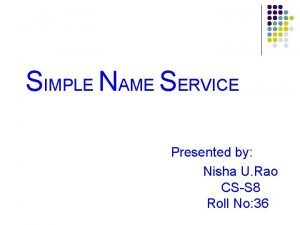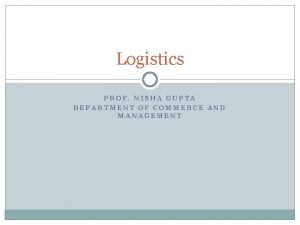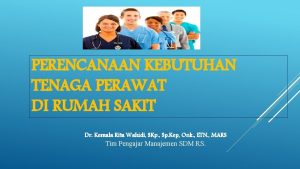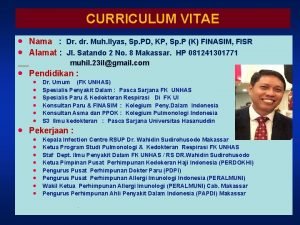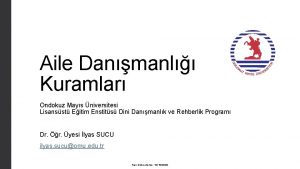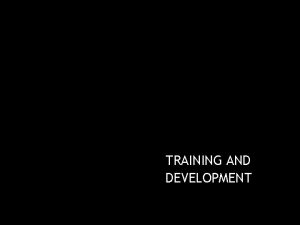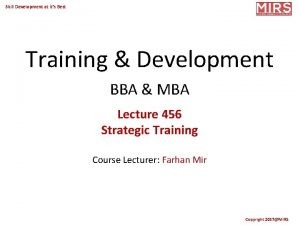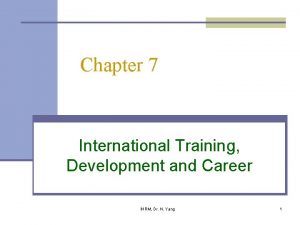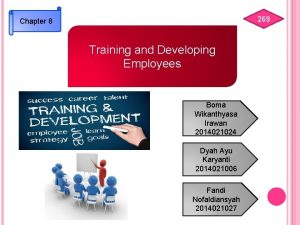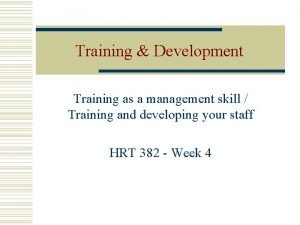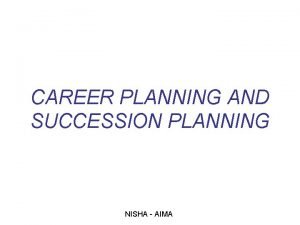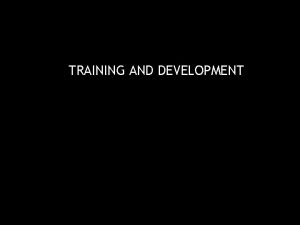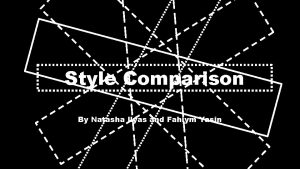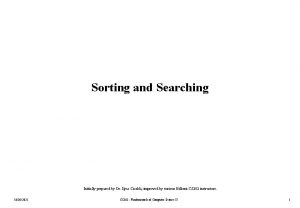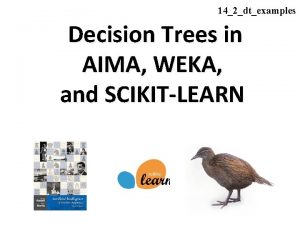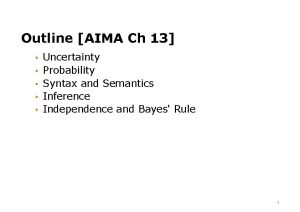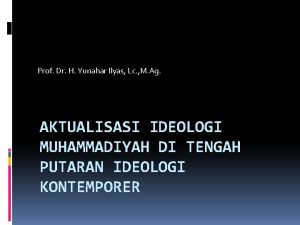Training and Development NISHA ILYAS AIMA Training A



























- Slides: 27

Training and Development NISHA ILYAS - AIMA

Training – A process whereby people acquire capabilities to aid in the achievement of organizational goals. – Employers spend billions on training annually Training is a planned programme designed to improve performance and bring about measurable changes in knowledge, skills, attitude and social behaviour of employees. A learning process that involves the acquisition of skills, concepts, rules, or attitudes to enhance employee performance. NISHA ILYAS - AIMA

The Nature of Training • Organization Competitiveness and Training – Training makes organizations more competitive – Training helps retain valuable employees – Training is no longer the first casualty of a business downturn. • Training as a Revenue Source – Marketing training with or alongside products can contribute significantly to a firm’s revenues. • Integration of Job Performance, Training, and Learning – Training is moving “closer to the job” to achieve “real time” learning. – Training is using more real-world problems to increase employee learning. NISHA ILYAS - AIMA

Performance Consulting NISHA ILYAS - AIMA

Features of Training • Increases knowledge and skills for doing a particular job • Focuses attention on the individual job. • Concentrates on individual employees • Gives importance to short term performance NISHA ILYAS - AIMA

Need For Training • helps new recruits to perform assigned tasks effectively • helps existing employees to prepare for higher level jobs • enables existing employees to keep in touch with latest developments • permits employees to cope with changes brought in by frequent transfers • makes employees more versatile, mobile, flexible and useful to the organisation • bridges the gap what the employee has and what the job demands allows an employee to gain acceptance from peer groups readily NISHA ILYAS - AIMA

Stages involved in a training programme • • • Casio, 1998 Determining training needs Organisational analysis Demographic analysis Task/knowledge, skills and attitudes(KSA) analysis • Person analysis NISHA ILYAS - AIMA

Training Process NISHA ILYAS - AIMA

Establishing Training Objectives • Gap Analysis – The distance between where an organization is with its employee capabilities and where it needs to be. • Types of Training Objectives – Knowledge: Impart cognitive information and details to trainees. – Skill: Develop behavior changes in how job and tasks are performed. – Attitude: Create interest and awareness of the training importance. NISHA ILYAS - AIMA

Learning: The Focus of Training • Learner Readiness – Ability to learn • Learners must possess basic skills (3 Rs) – Motivation to learn • Learners must desire and value training – Self-efficacy • Learners must believe that they can successfully learn the training content NISHA ILYAS - AIMA

Learning: Behaviors • Behavior Modeling – Copying someone else’s behavior by observing how another person deals with a problem. • Reinforcement – Law of effect states that people tend to repeat behaviors that are rewarded and avoid behaviors that are punished. • Immediate Confirmation – Reinforcement and feedback are most effective when given as soon as possible after training. NISHA ILYAS - AIMA

Learning: Types of Training Required and Regular Training Job/Technical Training Types of Training Interpersonal and Problem-Solving Training Developmental and Innovative Training NISHA ILYAS - AIMA

Training Methods • On-the-Job Training (OJT) • Apprenticeship Training • Cooperative Training, Internships, and Governmental Training • Classroom Instruction • Programmed Instruction • Audiovisual Methods • Computer-based Training and E-Learning • Simulation NISHA ILYAS - AIMA

On-the-job training (OJT) • On-the-job training (OJT) – Method by which employees are given handson experience with instructions from their supervisor or other trainer. – Problems with OJT • Poorly-qualified or indifferent trainers • Disruption of regular work • Bad or incorrect habits are passed on NISHA ILYAS - AIMA

On-The-Job Training Methods • Coaching: Here the supervisor explains things and answers questions; throws light on why things are done the way they are; offers a model for trainees to copy, conducts lot of decision making meetings, and allows trainees freedom to commit mistakes and learn. Coaching, thus, requires lot of teaching skills. • Mentoring: The use of an experienced person to teach and train someone with less knowledge and experience in a given area is known as mentoring. The mentor nurtures, supports and guides the efforts of young persons by giving appropriate information, feedback and encouragement whenever required. NISHA ILYAS - AIMA

On-The-Job Training Methods Job rotation: This kind of training involves the movement of trainee from one job to another. Apprenticeship training : System of training in which a worker entering the skilled trades is given thorough instruction and experience, both on and off the job, in the practical and theoretical aspects of the work. Cooperative Training : Training program that combines practical on -the-job experience with formal educational classes. Internship Programs : Programs jointly sponsored by colleges, universities, and other organizations that offer students the opportunity to gain real-life experience while allowing them to find out how they will perform in work organizations NISHA ILYAS - AIMA

Off The Job Training Methods • Vestibule Training – A special type of classroom facility is used to give instruction in the operation of equipment like that found in operating departments – The emphasis is on instruction rather than production. NISHA ILYAS - AIMA

Off The Job Training Methods • Computer-assisted Instruction (CAI) – A system that delivers instructional materials directly through a computer terminal in an interactive format. • Computer-managed Instruction (CMI) – A system normally employed in conjunction with CAI that uses a computer to generate and score tests and to determine the level of training proficiency. NISHA ILYAS - AIMA

Off The Job Training Methods • Role playing: This is a development technique requiring the trainee to assume a role in a given situation and act out behaviours associated with that role. • Lecture method: Here the instructor organises the study material on a specific topic and offers it to a group of trainees in the form of a talk. • Conference or discussion method: In this method the trainer delivers a lecture and involves the trainees in a discussion so that the doubts about the job to be undertaken get clarified. • Programmed instruction: This is an approach that puts material to be learned into highly organised logical sequences that require the trainees to respond. NISHA ILYAS - AIMA

Levels of Training Evaluation NISHA ILYAS - AIMA

Evaluation of A Training Programme • • • Should an evaluation be made? Who should evaluate? What is the purpose of evaluation? What will be measured? How comprehensive will the evaluation be? Who has the authority and responsibility? What are the sources of data? How will the data be collected and evaluated? How will the data be analysed and reported? NISHA ILYAS - AIMA

Methods of evaluation • • Questionnaires Tests Interviews Studies Human resource factors Cost benefit analysis Feedback. NISHA ILYAS - AIMA

Evaluation Designs Post-Measure Evaluation Design Pre-/Post-Measure with Control Group NISHA ILYAS - AIMA

Balancing Costs and Benefits of Training NISHA ILYAS - AIMA

Objectives of training NISHA ILYAS - AIMA

Training vs. Development NISHA ILYAS - AIMA

Training Pitfalls • • • Attempting to teach too quickly Trying to teach too much Viewing all trainees as the same Giving very little time to practice Offering very little to the trainee in the form of encouragement, praise or reward NISHA ILYAS - AIMA
 Agent aima
Agent aima Percept sentence
Percept sentence Aima python
Aima python Nisha patel family feud
Nisha patel family feud Nisha rao md
Nisha rao md Dr nisha patel
Dr nisha patel Nisha nagarajan
Nisha nagarajan Nisha patel md
Nisha patel md Nisha patel md
Nisha patel md Nisha singh md
Nisha singh md Nisha patel md
Nisha patel md Nisha rughwani
Nisha rughwani Jibran ilyas
Jibran ilyas Cara menghitung kebutuhan perawat di ruang icu
Cara menghitung kebutuhan perawat di ruang icu Maulana ilyas
Maulana ilyas Dokter ilyas paccerakkang
Dokter ilyas paccerakkang Ilyas neal
Ilyas neal Ilyas sucu omü
Ilyas sucu omü Ilyas çiçekli
Ilyas çiçekli Pluricatenaire
Pluricatenaire Adjacency matrix of weighted graph
Adjacency matrix of weighted graph Quotes about training and development
Quotes about training and development Differentiate between training and development
Differentiate between training and development Faculty model of training
Faculty model of training Free state training and development institute (fstdi)
Free state training and development institute (fstdi) International training career
International training career Chapter 8 training and developing employees
Chapter 8 training and developing employees Ask concept in training and development
Ask concept in training and development




